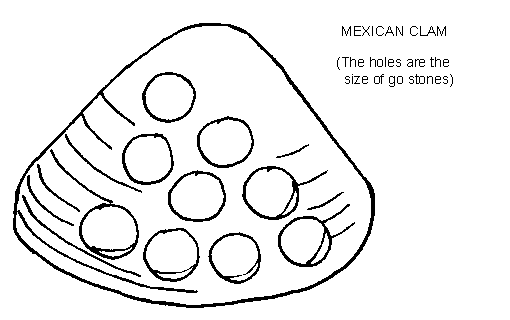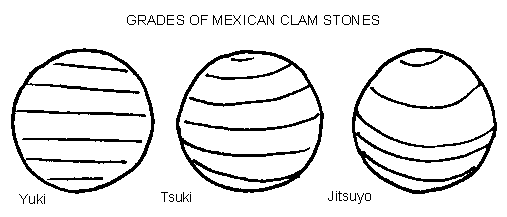Wood, Shell and Stone - Stuart DowseyGo StonesGo stones are available in a wide variety of materials: clam shell, slate, glass, plastic, pottery and even bamboo. In the West, other substitutes include tiddley-winks, button blanks, mapping pins and once in the Bristol area peppermints. Half the latter were painted black and after playing for a while the players' fingers acquired a strong minty odour. Standard stones are usually plastic or glass. Glass stones appear in five thicknesses to which the Japanese have given the traditional names - Matsu (pine) 10mm, Take (bamboo) 8.5mm, Ume (plum) 7.5mm, Sakura (cherry) 6.5mm and Tsubaki (camellia) 5.5mm.The best quality stones are made from clam shells and black slate. Nowadays most of the clam shell is obtained from the Gulf of California in Mexico, the shellfish themselves gracing the local tourist menu. Traditionally the best quality clam is found in Oguragahama, Hyuga, in Miyazaki prefecture and this still applies. The Hyuga clam shells are found on the seabed. A special sand-pump boat vacuum cleans to a depth of seven metres with a huge flexible pipe rather like an elephant's trunk, which brings up sand and stones as well as shells. The two types of clam shell resemble each other quite closely but the Mexican shell is larger and yields more stones. However, the Hyuga clam has less pronounced growth lines and is considered to be several grades better in appearance. This, together with their scarcity means that Hyuga shell stones are anything from four to ten times more expensive than their Mexican counterparts.  To obtain the stones, the clam shell is held firmly in a wooden chuck. Small discs are cut out one-by-one with a vertical drill. The best grain is found on the outer edge of the shell though this is normally the thinnest part. The flat sharp-edged discs are next rough-polished by machines to round off the edges. Finally they are given a finishing polish by hand. The smoothed disc is inserted into the end of a wooden stick and rubbed up and down a grooved piece of stone with a liquid abrasive. This polish is slightly alkaline and will affect the shell itself so the stones are washed clean throughout the polishing process. It takes 88 strokes to polish by hand. The two types of shell stones are also graded slightly differently. Hyuga shell stones are divided into Yuki (snow) which are pure white, Tsuki (moon) with a touch of yellow colouration and Hana (flower) in which the yellow colour is unmistakeable. Mexican shell stones are graded according to their grain or growth lines as their whiteness is more uniform. The three grades are Yuki with straight regularly spaced grain lines across the surface of the stone, Tsuki with curved or irregular lines and Jitsuyo (Utilitarian) with curved grain, no grain in parts or translucent shell.  Black go stones are mined in a slate quarry in Wakayama prefecture near Osaka. The slate is known as Nachiguro and is synonymous with high quality products. Its other uses are inkstones and doorsteps. The slate is easier to obtain and can be cut to any required thickness. The polishing is done entirely by a machine followed by washing in huge rotating wooden casks. Finally the stones are coated with a film of light machine oil to bring out the lustre of the slate. Before use surface oil must be removed. Stones are made up into sets according to their thickness. The numbering of the sets corresponds to the average thickness as follows: No.30 is 8.0mm thick, No.31: 8.4mm, No.32: 8.8mm, No.33: 9.2mm and so on. Originally the number related to its Japanese measurement but this has been changed. For example, No.32 was 3 fun 2 ri in traditional Japanese measurement but this has since been reduced by 2 ri so now No.32 is 3 fun or 8.8mms thick. To accommodate the optical effects of black and white the diameter of the white stones is set at 2.12cms and the black at 2.18cms. Prices reflect the skill, care, selection and availability of the stones. Middle of the range, No.32 Mexican Yuki cost just under £100, No.32 Tsuki cost about £75 and No.32 Jitsuyo £45. Top of the class are No.42 Mexican Yuki (11.9mm thick) at about £3,000 and No.38 Hyuga Yuki (10.7mm thick) are £8,000. Start saving up now. from the British Go Journal - No.52 (March 1981) |
go boards | go bowls | go home | weed's home page